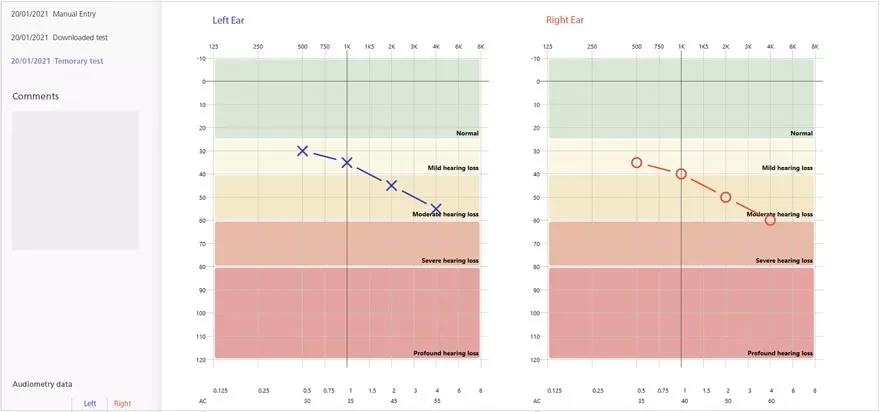The Short Increment Sensitivity Index (SISI) test is a hearing evaluation that assesses the function of the inner ear and auditory nerve. It measures the ability of the inner ear to identify small changes in sound intensity that are impossible for patients with normal hearing to perceive.

Image Credit: Amplivox UK
The name of the ability to recognize and respond to such changes is hyperacusis. It is an over-sensitivity to sound that frequently occurs due to damage to the cochlea (cochlear origin) or the ascending auditory pathway (retro cochlear origin).
Since the test compares two different lesions, it can be used in a test battery when evaluating a patient’s compatibility with a cochlear implant.
What is involved in a SISI test?
A SISI test involves a patient listening to a series of tones presented at 20 dB above their pure tone threshold for the test frequency. Short increments of intensity are then applied in bursts (each increment 1 dB louder than the continuous tone).1
The patient needs to respond to every increment to show that they can perceive the change. Normal listeners are not able to perceive these small increments. A total of 20 incremental bursts are usually employed and the test results are calculated as a percentage.
Why perform a SISI test?
The SISI test is frequently utilized to aid the diagnosis and identification of the lesion of sensorineural hearing loss, which is the result of damage to the inner ear or auditory nerve.
Measuring the sensitivity of the inner ear to small volume changes provides important feedback about the functionality of these structures and guides treatment options.
Overall, the SISI test is an invaluable tool used to evaluate hearing function and help healthcare professionals diagnose and treat various conditions that affect the auditory nerve and inner ear.
It can also be utilized to determine whether a disorder is cochlear or retrocochlear. Patients with a cochlear disorder can perceive increments of 1 dB, while those with a retrocochlear disorder cannot.
How to perform a SISI test?
This is the basic procedure for performing a SISI test:
- At the start of the test, make sure the patient is comfortable and understands the process.
- Provide headphones or insert earphones to the patient.
- Play an initial tone at a specific frequency and supra-threshold loudness. This will be continuous and serve as the reference tone. The frequency and loudness should vary depending on the specific testing protocol, as well as the individual's hearing level.
- Introduce a second tone as a short-duration increment, which equates to the "stimulus." It has the same frequency as the reference tone but slightly higher intensity (1 dB higher).
- Ask the patient to indicate whenever they sense a change in loudness between the reference tone and the stimulus tone through a verbal response, a button press, or a hand raise.
- Repeat the stimulation 20 times to obtain a percentage score of the number of correctly identified increments.
- Compute the SISI score by subtracting the number of correct responses from the total. Present the results as a percentage. A score of 0-20 % is considered normal, a score of 20-65 % is inconclusive, and a score of 75 % and above is positive.
The SISI test must be conducted by a trained healthcare professional or a licensed audiologist. Result interpretation similarly requires expertise and should be done within the context of the patient's overall hearing assessment.
SISI test results
The SISI test should be performed at 20 dB SL for the entire range of frequencies. If the patient scores low, it may be due to the presence of retrocochlear damage. The final percentage reveals whether the test is positive or negative.
Source: Amplivox
| Result SISI test conclusion recruitment |
| 70-100 % |
Positive |
| 35-65 % |
Indifferent |
| 0-30 % |
Negative |
A score of greater than 70 % indicates that the loss is due to a cochlear lesion. If the patient scores lower than 30 %, it is taken as an indication of normal listening or the presence of a central lesion (as the cause of hearing impairment). If between 30 % to 70 %, the results are inconclusive and a lesion cannot be confirmed.
Industry-leading audiometers
Amplivox offers a range of diagnostic audiometers with special test functionality:
The Model 260 is a portable and cost-effective diagnostic audiometer. it requires no configuration, set-up, or training, and has a user-friendly design.
The Model 270 audiometer boasts a two-channel diagnostic system with an extensive range of measurements for hearing aid fitting and diagnostic audiology, providing quick and efficient operation.
The Model 270+ audiometer is a powerful two-channel diagnostic system featuring enhanced technology for more effective and accurate testing.
About Amplivox
Amplivox creates a healthier future by providing accessible and accurate medical solutions for everyone.
As a manufacturer with more than 90 years of experience, we are proud to be a trusted partner to hearing and occupational health professionals all over the world by delivering a high level of knowledge-led solutions, service and support. We are here to be your preferred audiological and occupational health equipment provider.
Sponsored Content Policy: News-Medical.net publishes articles and related content that may be derived from sources where we have existing commercial relationships, provided such content adds value to the core editorial ethos of News-Medical.Net which is to educate and inform site visitors interested in medical research, science, medical devices and treatments.